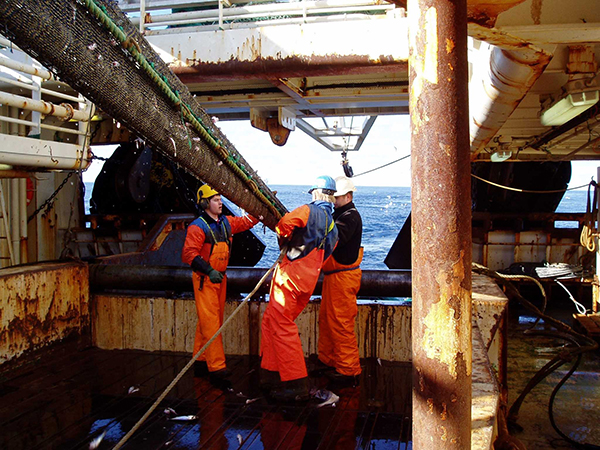The most common injuries are crush and impact injuries caused by wires, ropes, hooks, chains or trawl nets when taking on board catch. The trawl equipment is often heavy and exposed to substantial loads. Bad weather and heavy seas increase the risk of crush injuries.
The trawler deck can be slippery due to fish, fish residue, seawater, ice, etc., causing people to slip and fall. During rough sea, seawater can come up on deck through the trawl slipway, and, in a worst-case scenario, persons staying in the trawl alley may be washed overboard.
The NMA has also noticed that a number of accidents happen during maintenance work, particularly related to the hauling of heavy trawl doors. This is a very risky operation, particularly in bad weather, and special attention should be paid. The course and speed of the vessel should always be adjusted so that there is as little sudden movement as possible. These operations should preferably be carried out in calmer waters.
It is vital that the crew receives good training and practice, so that safe routines for the work operations are established. A risk assessment must be carried out for dangerous work on board, and the people responsible for performing this work must be present during the assessment.
Everyone must know their work positions on deck and safe passages during catch operations.
Safe zones on deck for when catching equipment is in motion must be defined, and command lines and forms of communication must be established. A new assessment must be made before any work is started in cases of maintenance or repair work not covered by any existing risk assessments.
Risk assessment
The NMA has developed an online tool for risk assessment. It is free to use and available on the NMA's website (available in Norwegian only).
A risk assessment may also be done in the way shown below, which is an example from a trawler company.
The risk assessment must include the risk elements involved for the various work operations, and preventive measures must be described to eliminate risk completely or reduce the risk to an acceptable level.
The key issue is that the crew members have a common understanding of the risk elements involved and are thoroughly trained and drilled to take necessary actions to prevent any dangerous situations from happening.
Risk assessment example:
|
|
||
|
Participants: The whole crew |
||
|
Task |
Risk element |
Preventive measures |
|
Hauling of trawl doors |
|
|
|
Shackling the sweep line winch pennants. |
|
|
|
Unshackling the trawl legs |
|
|
|
Trawl net retrieval process |
|
|
|
Emptying the trawler net |
|
|
Reference:
Regulations on the working environment, health and safety of persons working on board ship

